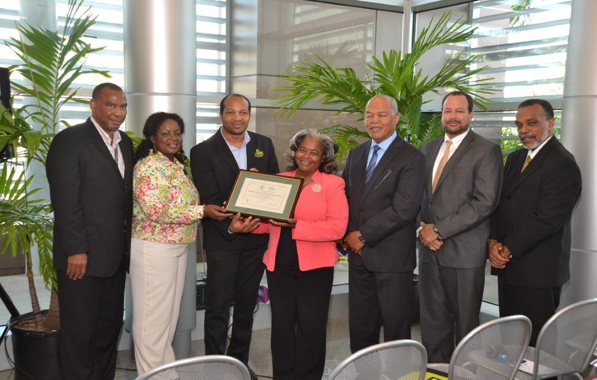Princess Margaret Hospital Lab, The Bahamas

From left to right: Dr. George Bruney (Lab Director), Dr. Ismae Whyms (Technical Director /Quality Manager), Mr. Hepburn Wint (Lead Assessor JANAAC), Ms. M.E. Lightbourne-Walker (Hospital Administrator), Mr. Hebert Brown (Managing Director , The Public Hospitals Authority), Mr. Frank Smith (Chairman, The Public Hospitals Authority), Dr. Glen Benebt (Chief Medical Officer MOH)
- What was the hardest thing to do in order to get accredited?
The hardest thing was organizing the documents, making sure all necessary documents were printed and had the correct version and that everything was being properly documented by staff.
- What was the easiest?
The easiest thing was labeling and organizing the binders or folders once the documents were organized.
- What was the most important contributing factor to getting accredited?
The most important contributing factor was having clear instructions from lab management on what needed to be done and how it should be done in regards to organization of documents and proper documentation. One Supervisor wrote, “…with all documents organized it was much easier to follow and comply with the quality system.”
- What steps did you take?
The steps we took involved writing and reviewing standard operating procedures (SOPs), reviewing logs, ensuring staff were properly documenting everything, bringing to the staff attention things that were overlooked so that it could be corrected, and getting staff involved so that they could feel a part of the process and take ownership of this endeavor.
- What were the biggest mistakes you made?
Some of the biggest mistakes were not following up on all corrective actions and assuming certain checks and balances that were delegated to junior staff were completed as requested.
- What is the best advice you can give to others?
- Having staff that can be dedicated to checking the SOPs and logs for compliance
- Getting all of the staff to ‘buy in’ to the process and see its importance as teamwork and cooperation is important
- Ensuring that the staff have a good understanding of the depth of their involvement in the process
- Ensuring that financial assistance and resources are available to offset any inventory or equipment purchasing challenges
- “…document everything, adjustments, calibrations, controls, rejections, results, validations, referrals, temperatures and inventory.”
